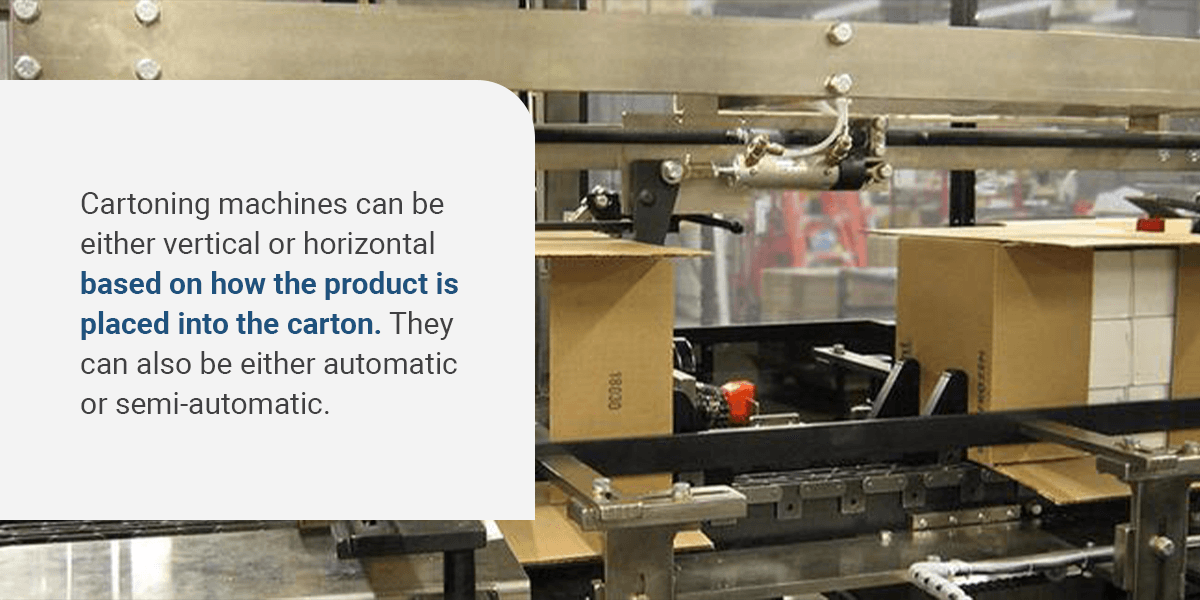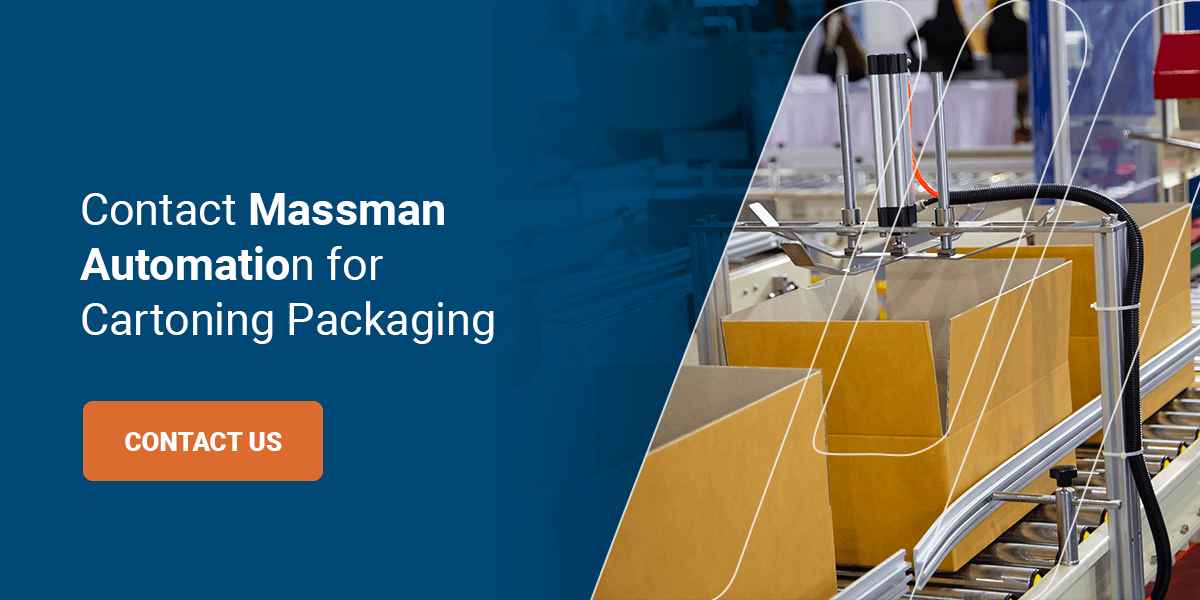15 February 2023 //
There are various ways to package products, including cans, pouches, and containers. One of the most popular and common methods of packaging is cartoning. It is a versatile and cost-effective packaging method that can handle high volumes of products. Nearly every industry, from cosmetics to food and pharmaceutical, uses cartoning because of its numerous benefits.
What Is Cartoning?
Cartoning involves using a cartoning machine to shape, fill and seal a carton board. Typically the cartoning machine will choose a carton board from a pile before folding and erecting it into the desired shaper. From there, the carton is usually filled with a product and then sealed. A carton can be filled with one or more products depending on your needs. The most well-known examples are milk and egg cartons, but cereal boxes, medical packaging, and other product packaging are also examples of cartoning.
Cartons can also be sealed in various ways. Some cartons use glue or adhesive to shut the ends and sides, while others may tuck the ends into each other. Some cartons use a combination of sealing methods, with some sides being glued while the ends are tucked. The material cartons are made of can hold a significant amount of product weight and have different designs printed on them.
Many cartoning machines include inkjet printers so they can also print on cartons. Various industries rely on cartoning to package their products, especially in the fast-moving consumer goods sector. Other industries that use cartoning include the pharmaceutical, confectionery, cosmetic, and food industries. Typically manufacturers will have cartoning machines as the last step in their manufacturing process. Many packaging companies and warehouses also offer cartoning as part of their storage, distribution, and packaging services.
Types of Cartoning Machines
There are different types of cartoning machines based on your specific packaging requirements. Cartoning machines can be either vertical or horizontal based on how the product is placed into the carton. They can also be either automatic or semi-automatic.

Horizontal
Products are inserted from the side of the carton in horizontal cartoning machines. They are also known as end-load or lateral cartoners and can be used in intermittent and continuous modes. The ends are closed using a hot melt application or by tucking flaps into each other. Horizontal cartoners are well-suited for industries that require bulk packaging at high speeds. Because of this, horizontal cartoners are commonly used by the end-of-line packing industry for various products including coffee, cereal, pizza, and rice.
Vertical Cartoning Machines
Vertical cartoning machines insert products from the top of the carton box. End flaps are then tucked, inserted, or glued together for closure. This type of cartoning is ideal for vials, jars, and bottles as it has short in-feed systems which reduce the possibility of damage. It is also well-suited for “bare” products such as grains and pasta as set amounts of products can be easily dropped into cartons before they are sealed.
Semi-Automatic Cartoning Machines
Semi-automatic cartoners require an operator to put the product into the carton, whether they are vertical or horizontal cartoning machines. There is no automatic infeed which simplifies the machine operation but reduces speed and output. They also need a significant number of operators to make production sustainable.
Automatic
Automatic cartoners automatically form, fill and seal cartons without the need for an operator. They have two modes, continuous and intermittent. The intermittent mode has a slower pace and pauses for the packing phase. This mode is well suited for specialized packaging of irregularly shaped products. Continuous mode is significantly faster with no pauses and is ideal for simple packaging or solid products with regular shapes. An automatic cartoning machine can be fitted with accessories that apply codes or insert leaflets.
Why Use Cartoning Packaging Machines?
Automated cartoning machines have several benefits for any manufacturer or packaging company. Carton packaging has many advantages over traditional packaging including increased efficiency, fewer errors, and lower costs. Here are some of the benefits of using automated cartoning machines:
- Cost-effective: Automated cartoning can help you reduce production costs. It is quick and easy to implement, allowing for high packaging volumes, which can decrease the cost per unit.
- Customizable: The materials used for cartoning are ideal for printing, enabling you to print various graphics and designs. You can add cut-outs and etching to cartons using specialized accessories to make them unique. Automatic cartoning machines can also handle different sizes and carton shapes with ease.
- Reduces errors: Human error is inevitable in most processes, leading to costly delays. Automatic cartoning is extremely precise and with less human intervention results in fewer errors and delays. This precision helps make automatic cartoning more cost-effective as there are fewer materials are wasted on mistakes, and there are fewer delays.
- Product safety: As cartons can be customized to fit the product, they can ensure the safety of delicate products such as glass vials, jars, and bottles.
- Efficient and fast: Automatic cartoning machines are significantly faster than manual or semi-automatic cartoning. This empowers your facility to complete packaging at a considerably quicker rate.
- Sustainable: Cartons can be made from a wide range of reused and recyclable materials.
- High quality: The efficiency and precision of automatic cartoning machines ensure you can consistently create high-quality packaging that exceeds your customer’s expectations.
- Employee safety: Automatic cartoning machines are safer than manual cartoning or packaging. Employees can avoid contact with heavy and potentially dangerous goods, improving your facility’s safety.
When to Use Cartoning Machines?
There are two ways manufacturers and packaging companies use cartoning machines for inline and offline packaging. In-line packaging is where products are placed straight into packaging once they have left the production line. In these instances, the speed of the cartoning machine needs to match the production rate. This method is used for products that require immediate packaging including frozen foods, prepackaged meals, and bare products. Many manufacturers prefer this method as it is fast and effective.
Offline packaging separates the production and packaging process more clearly. Packaging and production are independent processes. Products may be transported to another facility or undergo other processes before reaching the cartoning machine.
Contact Massman Automation for Cartoning Packaging
Massman has over 40 years of experience providing our partners with automated packaging equipment. We work closely with our partners in various industries to develop fit-for-purpose automated packaging systems for high-quality, effective packaging. Our durable and rugged equipment ensures our partners achieve high levels of reliability, value, and efficiency regardless of their industry.
Learn more about how we can help you create a custom end-of-the-line solution by requesting a consultation today or calling us at (320) 554-3611.

